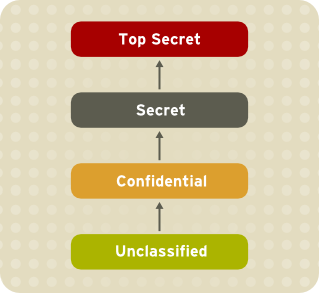Questo contenuto non è disponibile nella lingua selezionata.
49.6. Multi-Level Security (MLS)
Protecting sensitive or confidential data is paramount in many businesses. In the event such information is made public, businesses may face legal or financial ramifications. At the very least, they will suffer a loss of customer trust. In most cases, however, they can recover from these financial and other losses with appropriate investment or compensation.
The same cannot be said of the defense and related communities, which includes military services, intelligence organizations and some areas of police service. These organizations cannot easily recover should sensitive information be leaked, and may not recover at all. These communities require higher levels of security than those employed by businesses and other organizations.
Having information of different security levels on the same computer systems poses a real threat. It is not a straight-forward matter to isolate different information security levels, even though different users log in using different accounts, with different permissions and different access controls.
Some organizations go as far as to purchase dedicated systems for each security level. This is often prohibitively expensive, however. A mechanism is required to enable users at different security levels to access systems simultaneously, without fear of information contamination.
49.6.1. Why Multi-Level?
Copia collegamentoCollegamento copiato negli appunti!
The term multi-level arises from the defense community's security classifications: Confidential, Secret, and Top Secret.
Individuals must be granted appropriate clearances before they can see classified information. Those with Confidential clearance are only authorized to view Confidential documents; they are not trusted to look at Secret or Top Secret information. The rules that apply to data flow operate from lower levels to higher levels, and never the reverse. This is illustrated below.
Figure 49.2. Information Security Levels
49.6.1.1. The Bell-La Padula Model (BLP)
Copia collegamentoCollegamento copiato negli appunti!
SELinux, like most other systems that protect multi-level data, uses the BLP model. This model specifies how information can flow within the system based on labels attached to each subject and object. Refer to the following diagram:
Figure 49.3. Available data flows using an MLS system
Under such a system, users, computers, and networks use labels to indicate security levels. Data can flow between like levels, for example between "Secret" and "Secret", or from a lower level to a higher level. This means that users at level "Secret" can share data with one another, and can also retrieve information from Confidential-level (i.e., lower-level), users. However, data cannot flow from a higher level to a lower level. This prevents processes at the "Secret" level from viewing information classified as "Top Secret". It also prevents processes at a higher level from accidentally writing information to a lower level. This is referred to as the "no read up, no write down" model.
49.6.1.2. MLS and System Privileges
Copia collegamentoCollegamento copiato negli appunti!
MLS access rules are always combined with conventional access permissions (file permissions). For example, if a user with a security level of "Secret" uses Discretionary Access Control (DAC) to block access to a file by other users, this also blocks access by users with a security level of "Top Secret". A higher security clearance does not automatically give permission to arbitrarily browse a file system.
Users with top-level clearances do not automatically acquire administrative rights on multi-level systems. While they may have access to all information on the computer, this is different from having administrative rights.

